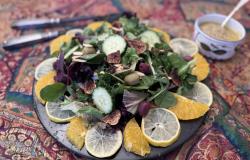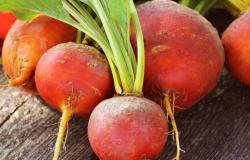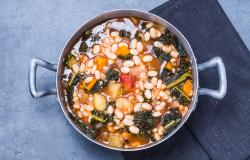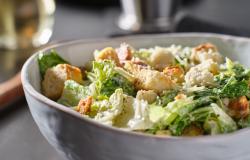Zuppa di Vongole e Fagioli (Clam Stew with Beans)
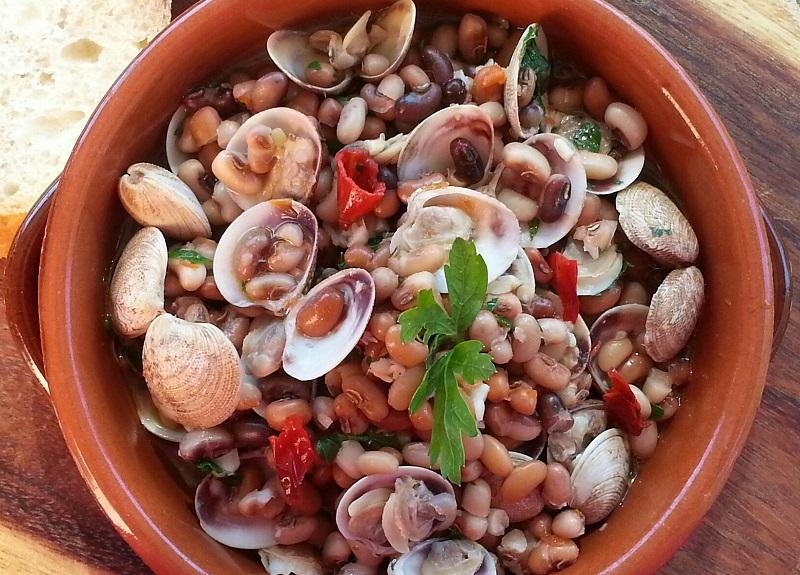
The clam known as vongola verace in Italy (Venerupis decussate) is from the large Veneridae family and is without a doubt the most prized clam to be found here—harvested so intensely from their native Mediterranean sea, in fact, that a cousin from the Indian Ocean, the so-called ‘falsa’ (false) vongola verace (Venerupis philippinarum) was introduced in the Adriatic sea to satisfy commercial demand for clams. Under Italian law, both types may be labelled verace, despite the non-native clam’s reputation as a less tasty imposter. Thus purists will advise that you look for the scientific name or, better yet, learn to spot the real deal. Decussate can be distinguished from pretenders by its ultra-fine ribbed pattern shell; its light grey to light brownish yellow coloring (as opposed to the philippinarum’s generally darker and more varied colors); and by the two spaced-apart siphons of the decussate’s hinge, whose shape recalls small horns and has earned the vongola verace the nickname ‘cornuta’ (horned).
This ‘truest’ of edible mollusks, the star of the Campania classic spaghetti alle vongole, is also very good in dishes with chick peas, lentils, and other legumes. For this recipe, they’ve been paired with a small multi-colored bean native to the Lake Trasimeno area of central Italy. But any small bean will do, such as navy beans or black-eyed beans.
Ingredients for 4-6 servings
Inspect the clams and toss out any with broken shells. Soak the clams for 2 to 3 hours in a large pot of cold water to which a small handful of rock salt has been added. Remove the clams using your hands or a scoop strainer (do not dump them into a colander) and check the bottom of the pot. If you find a lot of sand at the bottom of the pot, dump the water out, rinse and fill the pot again with fresh cold water and soak the clams for another hour. Strain again in the manner indicated above. Repeat again if necessary.
Cook the beans according to the package instructions. Strain and set the beans aside, saving one or two cups of the cooking liquid.
Peel and smash the garlic cloves. Slice the chilli pepper in half lengthwise and remove the seeds. Roughly chop the parsley leaves. Finely chop the parsley stems (and keep separate) and the shallot.
Pour about 3 tablespoons olive oil into a sturdy pan that is large enough to accommodate the clams and has (ideally) a glass lid. Cook the garlic and chilli pepper on medium heat for a couple minutes, swirling around periodically in the oil. Turn the heat to high, add the clams, and cover. Gently toss a couple times as they cook for a few minutes. Keep an eye on them. When most have opened, remove the lid and add the wine. Cook on high for another minute or two, letting the wine evaporate.
Place a large colander over a bowl or pot and carefully pour the clams over it, gathering the cooking the liquid and leaving the clams in the colander to cool (you might have to do this step in batches). When cool enough to handle, remove the meat from about two-thirds of the shells and set aside in a bowl. About one-third of the clams for the stew will stay in the shell. As you proceed, toss any clams that did not open during cooking. Strain the cooking liquid through cheesecloth or a fine mesh bag and set aside.
Rinse the cooking pan used for the clams (or wipe clean with a paper towel). Heat a couple tablespoons of olive oil in the pan and cook the shallot and parsley stems until soft. Now add the beans, stir, and cook for a couple minutes more. Add the clam cooking liquid and bring all to a simmer for about five minutes. Now add all the clams (the one-third in their shells and the meat from the two-thirds previously shelled) and combine. Depending on the consistency of soup you want, you could now add some of the (warmed) cooking liquid you set aside from the beans.
Be sure to test for salt before serving. Generally, recipes with clams never need additional salt, but here much will depend on how you’ve cooked the beans and how much of the liquid you add to the soup. Garnish with the fresh parsley leaves and additional chopped chilli pepper (optional), and serve with crunchy grilled bread.
Tips on buying and cooking clams:
If possible, inspect clams before purchasing. They should be closed tightly and unbroken.
Toss any clams with broken shells.
Soak clams in cold water prior to cooking.
Treat the clams gently; use your hands or a scoop strainer to gently lift them from their ‘bath’.
After cooking, toss out any clams that did not open (partially-opened clams are fine; toss those that remain completely sealed).
Don't overcook clams.
If using wine, do not add it during the initial phase of cooking when the pot is covered, otherwise it won't evaporate; rather, add the wine at the end and cook on high uncovered.
No additional salt.
Never toss the flavorful cooking liquid.
Always strain the cooking liquid.
